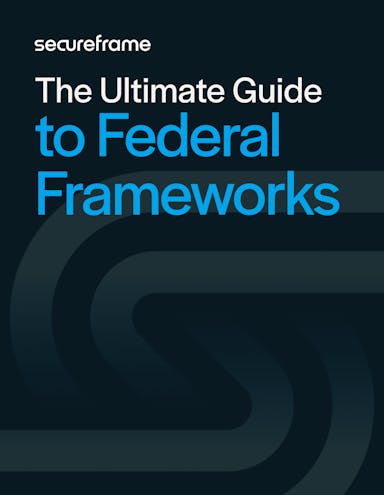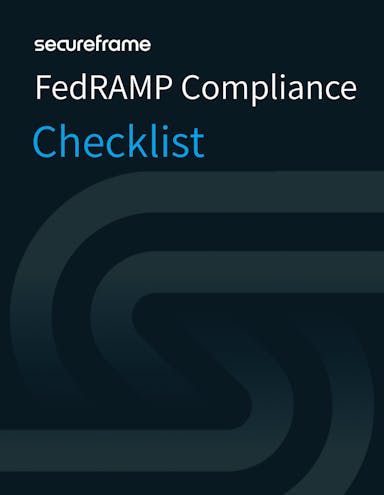
FedRAMP: What It Is, Who Needs It, and Where to Start
Emily Bonnie
Senior Content Marketing Manager
Rob Gutierrez
Senior Cybersecurity and Compliance Manager, CISA, CCSK, CMMC RP
FedRAMP sets the gold standard for cloud security, and achieving authorized status can open up significant growth opportunities in both government and private sectors. Understanding and navigating FedRAMP compliance, however, can be complex and full of questions.
Does your organization need to be FedRAMP compliant? Even if you’re not legally required to comply, what are the benefits of achieving FedRAMP authorization? What does the authorization process entail, and how do you get started? How much resources, time, and money will it take to get FedRAMP compliant?
This article demystifies FedRAMP authorization and offers practical guidance and best practices for organizations considering compliance.
What is FedRAMP?
The Federal Risk and Authorization Management Program (FedRAMP) is designed to ensure that all cloud services used by US federal agencies meet strict security requirements, mitigating the risk of data breaches and cyber threats. It provides a standardized approach to security assessment, authorization, and continuous monitoring for cloud technologies.
FedRAMP was introduced in 2011 and enacted into law in December 2022 as part of the US National Defense Authorization Act. With 27 applicable laws and regulations and another 26 standards and guidance documents, FedRAMP is one of the most rigorous cybersecurity certifications in the world.
What is the purpose of FedRAMP?
As federal agencies began to replace traditional software with cloud-based solutions, cloud service providers (CSPs) were required to prepare an authorization package for each agency they wanted to work with. Much like vendor security questionnaires, requirements for these authorization packages were inconsistent, resulting in significant manual and duplicate work for both cloud solutions creating the authorization packages and the agencies reviewing them.
FedRAMP offers a consistent, standardized approach to streamline this process. By using a "do once, use many" framework, FedRAMP enables CSPs and federal agencies to reuse existing security assessments, saving significant time and reducing duplicated efforts.
Benefits of FedRAMP Authorization
Cloud service providers that have a FedRAMP designation are listed in the FedRAMP Marketplace, a list of authorized services government agencies use to find new cloud-based solutions. A listing in the FedRAMP Marketplace makes you much more likely to get business from government agencies, since it’s easier for an agency to use a product that’s already authorized than to start the process with a new vendor. There are currently 326 FedRAMP Authorized Services in the Marketplace.
Beyond access to the federal market, a FedRAMP Marketplace listing can also give you a significant competitive advantage in the private sector. FedRAMP is a rigorous and respected security standard, so authorization can give current and potential customers the highest confidence in your commitment to meeting stringent cloud security standards.

The Ultimate Guide to Federal Frameworks
Get an overview of the most common federal frameworks, who they apply to, and what their requirements are.
Who needs to be FedRAMP compliant?
All cloud service providers that process or store federal data must be FedRAMP authorized.
This requirement extends to organizations that handle federal data, directly or indirectly, through cloud computing environments. It's not only the CSPs that need to be concerned with FedRAMP; federal agencies and state and local governments that use cloud services must also ensure their providers are compliant. In addition, businesses seeking to enter the federal marketplace must achieve FedRAMP authorization.

FedRAMP requirements
FedRAMP is a derivative of NIST Special Publication 800-53 and uses the same baselines (Low, Moderate, High) and associated controls, but adds to them by specifying certain parameters and additional control requirements.
For example, there is also a privacy control baseline that is applied to systems of every impact level. If a CSP processes personally identifiable information (PII), for instance, it must implement controls assigned to the privacy control baseline.
All organizations must implement controls assigned to their respective security control baseline. Low has the fewest number of controls, while High has the most controls and the strictest parameters.

FedRAMP requirements are broken down into 18 control families based on NIST 800-53 Rev. 5:
- Access Control
- Awareness and Training
- Audit and Accountability
- Security Assessment and Authorization
- Configuration Management
- Contingency Planning
- Identification and Authentication
- Incident Response
- Maintenance
- Media Protection
- Physical and Environmental Protection
- Planning
- Personnel Security
- Risk Assessment
- System and Services Acquisition
- System and Communication Protection
- System and Information Integrity
- Supply Chain Risk Management (new with Revision 5)
Recommended reading

A Guide to StateRAMP: Benefits, Requirements, and How to Get Authorized
Tips for getting started with FedRAMP compliance
Embarking on the journey to FedRAMP compliance can be a daunting task, but learning about the process and following best practices can make compliance much more manageable.
Here are some essential tips and best practices for organizations that are just getting started with FedRAMP compliance:
Thoroughly understand NIST SP 800-53 and FedRAMP requirements
Familiarize yourself with the FedRAMP Security Assessment Framework (SAF), NIST SP 800-53 security controls, and the specific requirements for the impact level (Low, Moderate, High) applicable to your cloud services.
Perform a gap analysis to understand how your current environment aligns with FedRAMP
This gap analysis should cover all aspects of your cloud service, from data encryption and user authentication to incident response and risk management practices. The outcome will provide a clear roadmap for bridging any gaps and ensuring your services are fully compliant with FedRAMP standards.
Secure support and commitment across your organization
Achieving FedRAMP compliance is a significant endeavor that requires a concerted effort across your organization. It's essential to garner support and commitment from both the executive leadership and the technical teams responsible for implementing the necessary changes. It can be a costly endeavor, so we recommend doing a budget and resource analysis to ensure feasibility and preparedness for the assessment and process.
This involves educating stakeholders about the value and implications of FedRAMP compliance, including the potential for expanded business opportunities within the federal market and the overall enhancement of your security posture. Establishing a cross-functional team dedicated to achieving compliance can facilitate collaboration and ensure that all efforts are aligned with your organization's goals.
Identify a federal agency partner
Partnering with a federal agency that either currently uses your service or is committed to adopting it can significantly streamline the FedRAMP authorization process. This partnership can also provide valuable insights into the specific security concerns and requirements of federal agencies, allowing you to tailor your compliance efforts more effectively.
In addition, having an agency sponsor can expedite the review process and add credibility to your FedRAMP application. Engaging early and frequently with potential agency partners can help build relationships and secure the necessary commitment to move forward.
Carefully define your system boundaries
A critical step in the FedRAMP compliance process is accurately defining the boundaries of your cloud system. This includes:
- Internal Components: Identifying all elements within your cloud service, from infrastructure and applications to data storage and processing units, ensuring that security controls are uniformly applied.
- External Service Connections: Cataloging all connections to external services and third-party providers, assessing the security implications of these integrations, and ensuring they do not compromise your compliance posture. If you don't have on-premise components and rely on cloud services such as AWS, Azure, or Google Cloud Platform, there may be areas of shared responsibility or inheritance for controls.
- Data and Metadata Flows: Mapping out the flow of data and metadata within and outside your system to understand potential vulnerabilities and apply appropriate security measures. This comprehensive understanding of your system's boundaries is essential for implementing effective security controls and for documenting your security posture in the System Security Plan (SSP) required for FedRAMP authorization.
Approach FedRAMP as an ongoing commitment
FedRAMP compliance is not a one-time achievement — it’s an ongoing, continuous commitment to maintaining high security standards. It requires regular monitoring, updating security controls, and periodic reassessments to adapt to evolving threats and changes in your cloud services and threat landscape. Adopting a mindset that views FedRAMP as an integral part of your operational processes will help you stay compliant and secure over time.
Engage with the FedRAMP PMO
The FedRAMP Program Management Office (PMO) is an essential resource for organizations pursuing authorized status. They share best practices, training, FAQs, and templates to help simplify and guide CSPs through the process.
The PMO can provide guidance on technical requirements, clarify compliance criteria, and offer insights into the authorization process. Engaging with the PMO early and often can help you navigate the complexities of FedRAMP, avoid common pitfalls, and develop a successful strategy for achieving and maintaining compliance.

FedRAMP Compliance Checklist
Get a step-by-step checklist to walk you through the process of preparing for FedRAMP authorization.
How to streamline FedRAMP compliance with automation + AI
Because it’s a rigorous standard, achieving FedRAMP compliance requires a significant amount of time and resources. You’ll need to complete a gap analysis and readiness assessment, determine your baseline, select and implement NIST 800-53 controls, and collect documentation and evidence for your 3PAO. And once that’s done, you’ll have to conduct ongoing assessments and continuous monitoring to maintain compliance.
GRC automation platforms like Secureframe can significantly cut down on the amount of time and effort it takes to complete these manual tasks, freeing up your team to focus on strategic objectives.
Here are a few reasons organizations choose Secureframe as their partner for achieving and maintaining compliance with federal frameworks:
- Government and federal compliance expertise: Our dedicated, world-class compliance team includes former FISMA, FedRAMP, and CMMC auditors who have the expertise and experience to support you at every step.
- Integrations with federal cloud products: Secureframe integrates with your existing tech stack, including AWS GovCloud, to automate infrastructure monitoring and evidence collection.
- Trusted 3PAO partner network: Secureframe has strong relationships with certified Third Party Assessment Organizations like Schellman and Prescient Assurance, and can support FedRAMP and other federal audits such as CMMC and CJIS.
- Cross-mapping across frameworks: FedRAMP and NIST 800-53 have many overlapping requirements with NIST 800-171, CJIS, and other federal frameworks. Instead of starting from scratch, our platform can help map what you’ve already done for FedRAMP to other frameworks so you’re never duplicating efforts.
- Continuous monitoring: By monitoring your tech stack 24/7 to alert you of non-conformities, Secureframe makes it easier to maintain continuous compliance and a strong security posture. You can specify test intervals and notifications for required regular tasks to maintain FedRAMP compliance. You can also use our Risk Register and Risk Management capabilities to support your continuous monitoring efforts and POA&M maintenance.
To learn more about how Secureframe can help you comply with FedRAMP and other federal frameworks, schedule a demo with a product expert.
Use trust to accelerate growth
FAQs
What is FedRAMP in simple terms?
FedRAMP is a government-wide program that sets security standards for cloud services used by the U.S. government. You can think of it as a security checkpoint that cloud services must pass to work with federal government agencies.
What does FedRAMP stand for?
FedRAMP stands for the Federal Risk and Authorization Management Program.
Is FedRAMP mandatory?
FedRAMP authorization is mandatory for cloud service providers (CSPs) that want to work with federal agencies.
Who needs to be FedRAMP certified?
Cloud service providers that offer services to U.S. federal agencies need to be FedRAMP authorized. This can include Software-as-a-Service (SaaS), Infrastructure-as-a-Service (IaaS), and Platform-as-a-Service (PaaS) providers that handle government data.
Is FedRAMP only for government?
While FedRAMP is designed for government use, its rigorous standards are often adopted by private sector companies seeking to enhance their cloud security posture, especially those wishing to do business with the government.
Who governs FedRAMP?
FedRAMP is governed by the FedRAMP Board, which includes the Chief Information Officers of:
- The Department of Homeland Security (DHS)
- The General Services Administration (GSA)
- The Department of Defense (DoD)
What is the difference between NIST and FedRAMP?
NIST (National Institute of Standards and Technology) creates a wide range of security standards and guidelines, including those for cybersecurity. FedRAMP is a program that applies NIST's security standards specifically to cloud services used by the federal government, adding a layer of requirements and processes for authorization and continuous monitoring. Essentially, FedRAMP builds on NIST standards to ensure cloud services meet the specific needs of federal agencies.
What are the three levels of FedRAMP?
Low, Moderate, and High Impact
Is GovCloud required for FedRAMP authorization?
Only for FedRAMP High. However, many organizations going for Moderate use it because they want to or are required to by the agencies they work with. AWS US East/West is authorized for FedRAMP Moderate. GovCloud is not required for FedRAMP Low.

Emily Bonnie
Senior Content Marketing Manager
Emily Bonnie is a seasoned digital marketing strategist with over ten years of experience creating content that attracts, engages, and converts for leading SaaS companies. At Secureframe, she helps demystify complex governance, risk, and compliance (GRC) topics, turning technical frameworks and regulations into accessible, actionable guidance. Her work aims to empower organizations of all sizes to strengthen their security posture, streamline compliance, and build lasting trust with customers.

Rob Gutierrez
Senior Cybersecurity and Compliance Manager, CISA, CCSK, CMMC RP
Rob Gutierrez is an information security leader with nearly a decade of experience in GRC, IT audit, cybersecurity, FedRAMP, cloud, and supply chain assessments. As a former auditor and security consultant, Rob performed and managed CMMC, FedRAMP, FISMA, and other security and regulatory audits. At Secureframe, he’s helped hundreds of customers achieve compliance with federal and commercial frameworks, including NIST 800-171, NIST 800-53, FedRAMP, CMMC, SOC 2, and ISO 27001.
